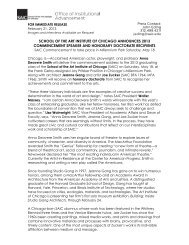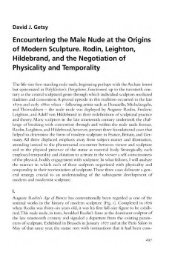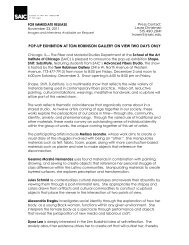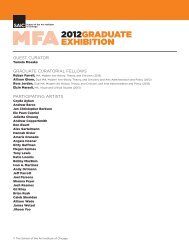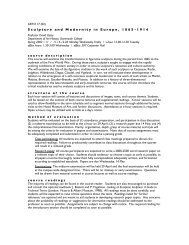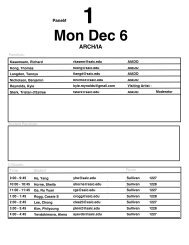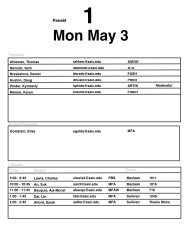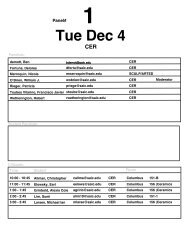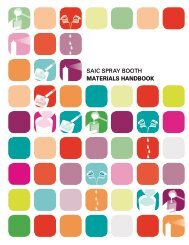i. institutional support and commitment to continuous improvement
i. institutional support and commitment to continuous improvement
i. institutional support and commitment to continuous improvement
Create successful ePaper yourself
Turn your PDF publications into a flip-book with our unique Google optimized e-Paper software.
I. Institutional Support <strong>and</strong> Commitment <strong>to</strong> Continuous Improvement<br />
of courses that provide structure <strong>to</strong> the undergraduate curriculum <strong>and</strong> making advising<br />
processes more pervasive is expected <strong>to</strong> alleviate these concerns. Greater student<br />
satisfaction <strong>and</strong> higher retention rates are some of the goals of this initiative.<br />
o Strengthen Research <strong>and</strong> Collaboration<br />
Many areas of the School—especially in the professional programs like MArch—have<br />
established, collaborative projects with other art institutions <strong>and</strong> other industries. Still,<br />
the School wants <strong>to</strong> increase the number of student <strong>and</strong> faculty research projects as well<br />
as cultivate a better School-wide awareness of those projects better. Improving alumni<br />
participation in current School activity is seen as part of this effort. An appreciable<br />
increase in the kind, frequency, <strong>and</strong> value of such partnerships over a five-year period is<br />
the goal of this initiative.<br />
In Fall 2010, the Strategic Planning Committee will begin its final function as a steering committee,<br />
working with SAIC administration <strong>and</strong> faculty governance <strong>to</strong> identify or establish Action Groups,<br />
who undertake addressing the Strategic Initiative, using the Core Values as a guide <strong>to</strong> adjudicate<br />
their actions. The Strategic Planning Committee will oversee these activities, <strong>and</strong> help coordinate<br />
collaborations among the Action Groups, which may be working on similar goals from different angles.<br />
Finally, the Strategic Planning Committee will continue <strong>to</strong> help each Action Group evaluate its progress<br />
over the five-year period.<br />
I. INSTITUTIONAL SUPPORT AND COMMITMENT TO<br />
CONTINUOUS IMPROVEMENT<br />
I.1. IDENTITY AND SELF ASSESSMENT<br />
I.1.5. Self-Assessment Procedures<br />
As in planning initiatives, assessment procedures happen at both departmental <strong>and</strong> <strong>institutional</strong> levels.<br />
A) Departmental self-assessment<br />
His<strong>to</strong>rical <strong>and</strong> recent assessment activities of the AIADO department are discussed below. A final<br />
section gives an overview of regular departmental assessment procedures.<br />
1) Self studies in 1991 <strong>and</strong> 2001: strengths <strong>and</strong> challenges<br />
As an institution that is both regionally <strong>and</strong> nationally accredited—as a charter member of the<br />
National Association of Schools of Art <strong>and</strong> Design since 1944, <strong>and</strong> <strong>continuous</strong>ly accredited since<br />
1936 by the North Central Association of Colleges <strong>and</strong> Schools—the School is subject <strong>to</strong> self-review<br />
in preparation for re-accreditation every ten years. Each department is required <strong>to</strong> both quantify <strong>and</strong><br />
qualify its programs, faculty <strong>and</strong> student population through three lenses—by defining the present,<br />
then projecting ten years in the future, <strong>and</strong> reflecting ten years in the past, <strong>and</strong> comparing that view<br />
<strong>to</strong> what was projected ten years prior for the previous review as the department imagined its future.<br />
Reports written by <strong>and</strong> about the Department of Interior Architecture in both 1991 <strong>and</strong> 2001 provide<br />
compelling overviews of the department <strong>and</strong> its evolution in the past twenty-five years. Over<br />
time these reports are a privileged piece of his<strong>to</strong>ry, <strong>and</strong> serve as a springboard from which the<br />
department can continue <strong>to</strong> assess its progress as it meets programmatic, curricular, <strong>and</strong> facility<br />
upgrade <strong>and</strong> expansion. In 2001 the department identified seven full-time faculty associated with<br />
33 | Spring 2011<br />
SECTION I Institutional Support <strong>and</strong> Commitment <strong>to</strong> Continuous Improvement



